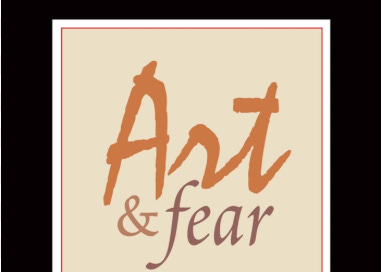One of my favorite books about creativity is Art & Fear: Observations on the Perils and Rewards of Artmaking. It focuses on the relationship you have with yourself as a creative person. It was one of a handful of references for me in trying to write Why Design Is Hard. I’ve read Art & Fear many times and wanted to learn from its style of giving tough, valuable advice but in a concise and supportive way.
My only disclaimer for reading it as a designer is this: it’s critical to remember that while art and design are creative processes, they have major differences. Designers get in trouble when they relate to their work too much like artists do. Artists have the luxury of focusing on personal expression and satisfying themselves (if they can). Whereas designers are hired to satisfy, and collaborate with, other people. I wrote about how self-destructive the ego-trap is for designers, and it is a central message of Why Design Is Hard.
Otherwise much of the advice in Art & Fear, especially the first parts, applies well. Just keep the design/art distinction in mind. You may love to make art as a hobby, and have design as a profession, but be careful not to get them confused. With that, here are some of my favorite quotes from Art & Fear, with brief notes.
There is probably no clearer waste of psychic energy than worrying about how much talent you have — and probably no worry more common. [see talent is a distraction]
Fears about artmaking fall into two families: fears about yourself, and fears about your reception by others. In a general way, fears about yourself prevent you from doing your best work, while fears about your reception by others prevent you from doing your own work.
We forget how special it is to get paid to make things other people will use. We help create worlds and spaces that other people may spend hours, weeks or months of their lives using. Even if your contributions to these worlds are small, take pride in it. Working with ideas all day is a dream job for most of the 9-5 working world.
Most of us spend most of our time in other peoples’ worlds — working at predetermined jobs, relaxing to pre-packaged entertainment — and no matter how benign this ready-made world may be, there will always be times when something is missing or doesn’t quite ring true. And so you make your place in the world by making part of it — by contributing some new part to the set. And surely one of the more astonishing rewards of artmaking comes when people make time to visit the world you have created. Some, indeed, may even purchase a piece of your world to carry back and adopt as their own. Each new piece of your art enlarges our reality. The world is not yet done.
Do the designers you talk to most have courage? It’s easy to fall in with people who share your complaints, more than those who have matured past those problems or learned to accept them. Try to find communities of pragmatism and courage.
What artists learn from other artists is not so much history or technique (although we learn tons of that too); what we really gain from the artmaking of others is courage-by-association. Depth of contact grows as fears are shared — and thereby disarmed — and this comes from embracing art as process, and artists as kindred spirits. To the artist, art is a verb.
Design pragmatism means you care primarily about the ends, more than the means. What have you made better? And for whom? Rather than caring more about the technique applied or the craft it demonstrates.
Art that deals with ideas is more interesting than art that deals with technique.
Perfectionism can be a superpower, but only when it’s applied by choice to situations where the effort is worth it. Compulsive perfectionism skews priorities and makes you harder to collaborate with.
Your job as an artist is to push craft to its limits — without being trapped by it. The trap is perfection: unless your work continually generates new and unresolved issues, there’s no reason for your next work to be any different from the last. The difference between art and craft lies not in the tools you hold in your hands, but in the mental set that guides them. For the artisan, craft is an end in itself. For you, the artist, craft is the vehicle for expressing your vision. Craft is the visible edge of art.




